Organising Chapter Notes | Business Studies (BST) Class 12 - Commerce PDF Download
Introduction
After setting objectives, the next step is to organise resources by dividing work, using them wisely, and empowering employees. Good organisation helps businesses adapt and carry out plans, as seen in Wipro’s success through customer focus, product diversification, and aligned management. It provides structure by defining roles, clarifying responsibilities, and grouping activities logically, which ensures cooperation, avoids confusion, and directs efforts towards common goals.
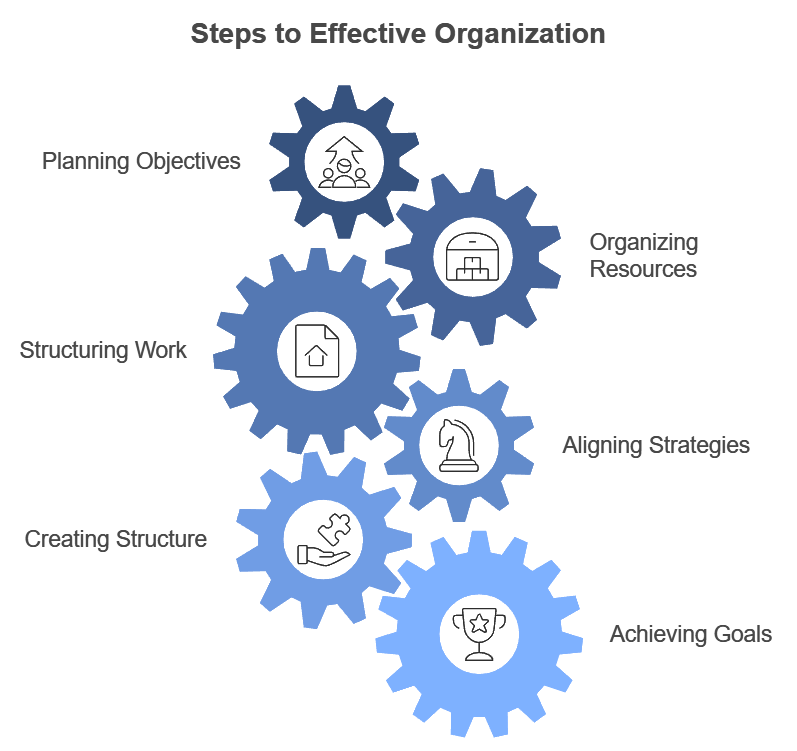
Meaning
- Organising, as a process, involves the coordination of human efforts and resources towards achieving set objectives.
- The process of organising facilitates the implementation of plans by defining jobs, establishing work relationships, and effectively allocating resources to achieve desired goals.
'Organizing is the systematic process of identifying and categorizing tasks, delineating and assigningresponsibilities and authority, and establishing connections to enhance collective efficiency in achieving objectives.'
Steps Involved in the Process of Organising
Organising means taking a few important steps to reach a goal in a smooth and effective way.
- Identification and Division of Work: This initial step involves breaking down the overall work into specific, manageable tasks, ensuring clarity and focus in execution.
- Departmentalisation: Grouping similar activities into departments or units for specialisation and efficiency. This can be based on functions, products, or geographical areas.
- Assignment of Duties: Allocating specific tasks to individuals or departments, aligning them with appropriate responsibilities based on skills and competencies.
- Establishing Reporting Relationships: Defining clear lines of authority and communication, clarifying who reports to whom, and establishing a hierarchical structure for accountability and coordination.
- Adaptation to Change: The organising process helps a business adjust to changes in the market, providing stability and allowing smooth transitions.
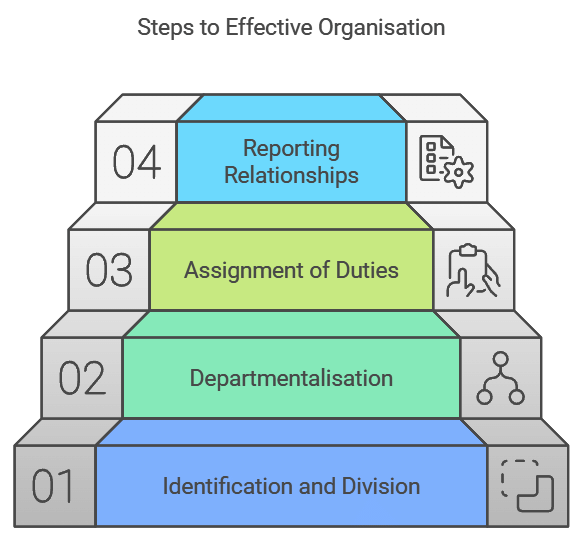 Steps to Effective Organisation
Steps to Effective Organisation
Importance of Organising
Organising helps a business adjust smoothly to changes in the market. Here are some key benefits of organising:
(i) Benefits of specialisation
Organising ensures that tasks are divided and given to the right people. When workers keep doing the same task, they get better at it. This reduces their workload and increases their efficiency and productivity.
(ii) Clarity in working relationships
It clearly defines who reports to whom. This removes confusion, improves communication, and makes sure everyone knows their responsibilities and limits of authority.
(iii) Optimum utilisation of resources
Organising ensures that all resources—people, money, and materials—are used properly. It avoids duplication of work, reduces waste, and ensures tasks are completed efficiently.
(iv) Adaptation to change
Organising allows a business to adjust to changes in the market. It makes it easier to change the structure or roles when needed. This helps the business remain stable and continue growing even during tough times.
(v) Effective administration
It provides clarity about each job and its duties, helping to avoid confusion. This makes it easier for the management to run the business smoothly and efficiently.
(vi) Development of personnel
Organising encourages managers to delegate routine tasks. This not only reduces their workload but also gives them time to think of new ideas. Delegation also helps subordinates grow by giving them chances to face challenges and improve their skills.
(vii) Expansion and growth
Organising supports growth by helping the business take on new tasks, open new departments, and enter new markets. This leads to more customers, more sales, and higher profits.
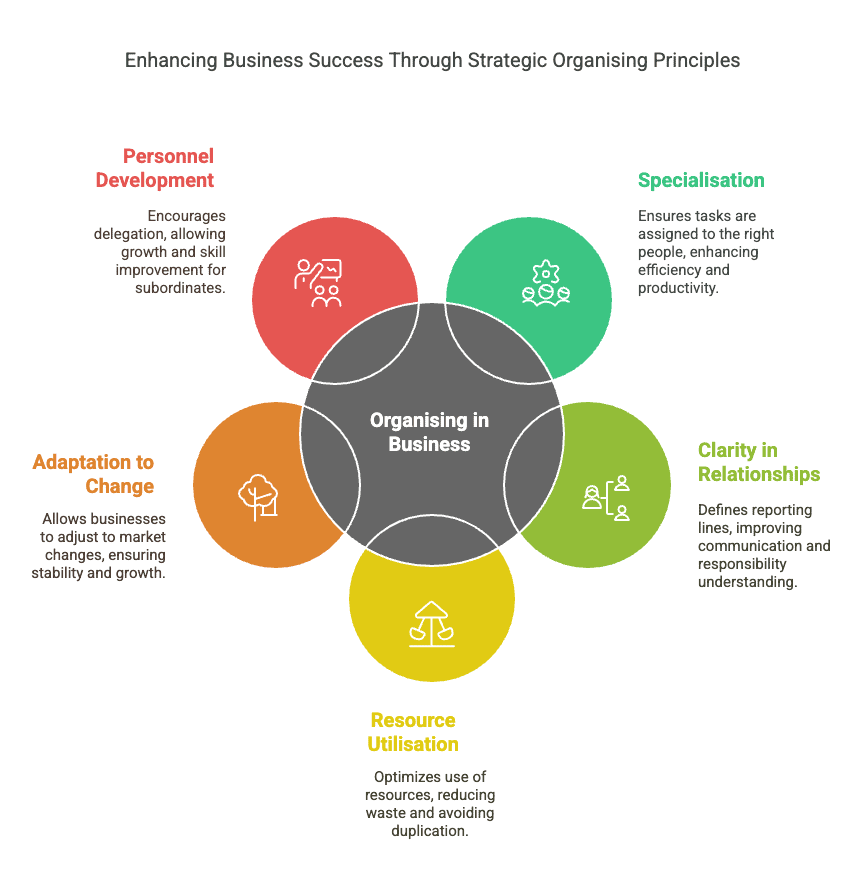
Organisational Structure
- Organisation structure is what you get after planning how work will be done in a company. A good structure helps the business run smoothly and make more profit. When a company grows or becomes more complex, it needs to change its structure to keep up. Businesses that don’t want to grow may keep the same structure for years, but that can become a problem. If a business doesn’t adjust with time, it might stop growing or even fail.
- As a company grows, new tasks and departments come up, and it becomes harder to manage everything. That’s why having the right structure is so important—it helps the company stay organised and deal with changes easily.
- Management expert Peter Drucker said that the structure of a business is extremely important. If the structure is wrong, it can badly affect performance or even ruin the business.
- An organisation's structure is like a plan that shows who does what, who reports to whom, and how resources are used. It helps people work together and reach the company’s goals. This structure is usually shown through an organisation chart.
- A key part of this is the span of management, which means how many people one manager can handle well. This decides how many levels of managers the company needs.
- A clear structure makes communication better and helps managers keep things under control. It also helps the company work as one team by clearly defining everyone's roles and responsibilities.
Let’s understand this with an example:
Sunita starts her own travel agency. She knows that her business will only succeed if customers and employees work well together. So, she divides the work into three areas:
Operations – travel counsellors, ticketing, and customer service
Sales – accounts executive
Administration – bookkeeper, cashier, and support staff
By dividing the work like this, Sunita creates a simple and clear organisation structure where everyone knows what they have to do and who they report to. This makes her business more organised and effective.

Types of Organisation Structures
1. Functional Structure
In a functional structure, tasks are organised, and departments are formed based on specific functions to be carried out. For instance, all responsibilities related to production are consolidated under the production department, while sales-related tasks are grouped under the sales department.
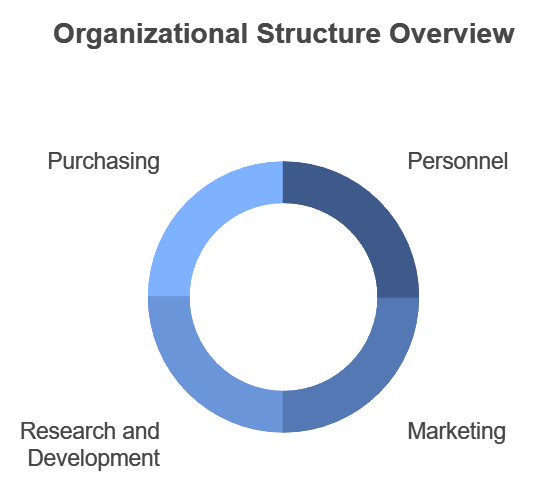
Advantages
- Skill Specialisation: Functional structure focuses on specific roles, which increases efficiency as employees develop expertise in particular areas.
- Improved Coordination: This structure promotes better control and coordination within departments due to task similarities, resulting in smoother operations.
- Enhanced Efficiency: The functional structure can improve both managerial and operational efficiency, potentially leading to increased profits.
- Economies of Scale: Reduced duplication of efforts in a functional structure can lead to cost savings through economies of scale.
- Simplified Training: With a narrower focus on skills, training for employees becomes more straightforward and targeted.
- Balanced Attention: The functional structure ensures that all functions receive necessary attention, preventing any area from being overlooked.
Disadvantages
- Functional Structure Drawbacks: A functional structure can sometimes overemphasise a single function, leading to "functional empires." This can result in departments prioritising their own goals over the organisation's objectives and limiting interdepartmental collaboration.
- Coordination Problems: Information exchange between different departments can be difficult in a functional structure, leading to coordination challenges.
- Conflict of Interests: In a functional structure, conflicts can arise when departmental interests clash, such as when a sales department's customer-friendly design request complicates production.
- Inflexibility and Limited Training Opportunities: A functional structure can foster a narrow perspective among staff with similar skills and knowledge, limiting their ability to understand differing viewpoints.
Suitability
- Large organisations that manufacture a single product line.
- Businesses require significant functional specialisation across various activities.
- Most effective in large organisations with diverse activities needing a high level of specialisation.
2. Divisional Structure
The organisational structure known as divisional structure involves organising the entire enterprise based on the major products to be manufactured, such as metal, plastic, cosmetics, etc.

Advantages
- Skill Development: Specialising in products allows divisional heads to develop diverse skills, preparing them for more senior roles.
- Accountability: Divisional heads are accountable for profits since revenues and costs for each department are clearly identified, making it easier to measure performance.
- Autonomy and Quick Decision-Making: Each division operates independently, promoting flexibility and enabling faster decisions.
- Facilitation of Expansion: The divisional structure allows for growth, as new divisions can be added without disrupting existing operations.
- Self-Contained Divisions: Each division is independent and develops expertise in all areas related to its product line.
- Profit Centres: Each division acts as a profit centre, with the divisional head responsible for its financial outcomes.
Disadvantages
- Conflicts Arising from Resource Allocation: Divisions may experience conflicts when determining the allocation of resources among them.
- Repetition of Functions: All divisions necessitate a complete set of functions, leading to redundant efforts across divisions and an associated increase in costs.
- Self-Centric Behaviour: Each division endeavours to showcase superior performance, occasionally even at the expense of other divisions, reflecting a self-centred attitude.
Suitability
- This structure is appropriate for organizations engaged in the production of multiple products or diverse product lines that demand a focus on product specialization.
- Additionally, growing companies aiming to incorporate additional product lines in the future often choose to adopt this structure.
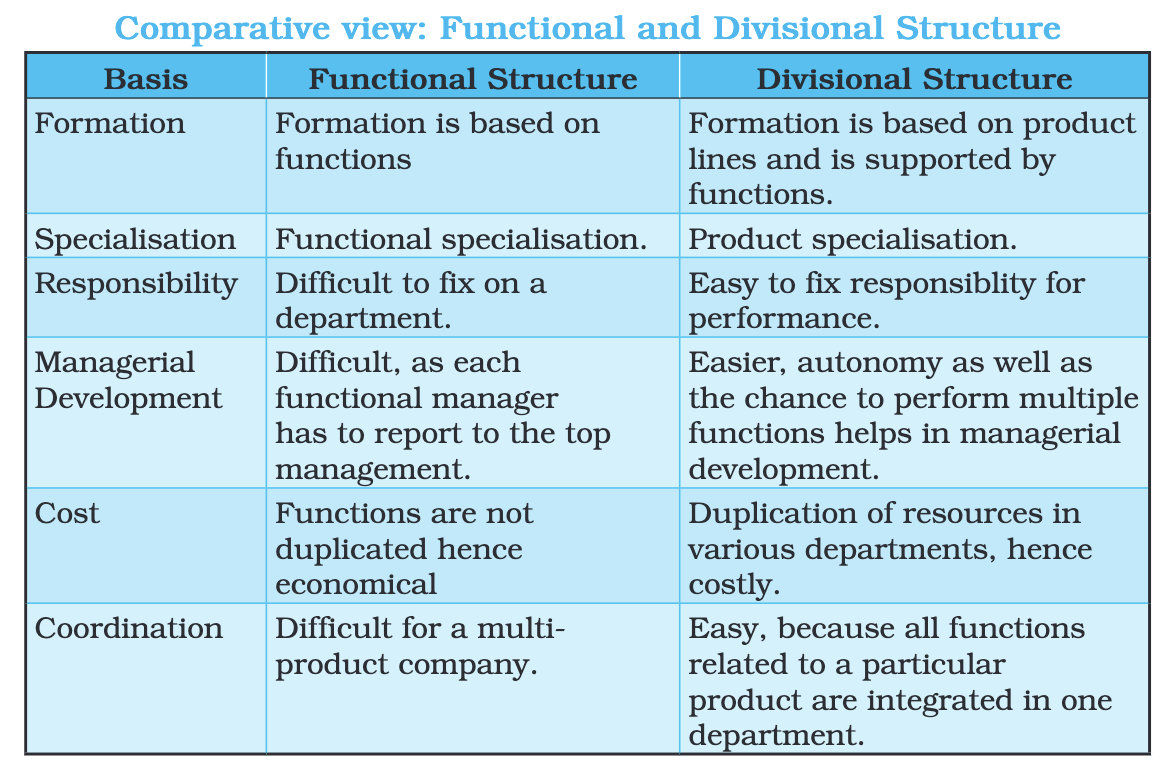
Formal and Informal Organisation
1. Formal Organisation
- Describes the organisational structure intentionally crafted by management to achieve organisational objectives.
- It distinctly outlines the limits of authority and responsibility, promoting systematic coordination among various activities to reach organisational goals.
- According to Louis Allen, it is a system comprising well-defined jobs, each carrying a specific level of authority, responsibility, and accountability.
Features
- The formal organisation clearly defines the hierarchy of job positions and their interconnections, clarifying the reporting lines.
- The formal organisation serves as a mechanism to achieve planned objectives by establishing necessary rules and procedures.
- It ensures the coordination, linking, and integration of efforts across multiple departments.
- Top management intentionally designs the formal organisation to enable smooth operations.
- The focus of a formal organisation is more on the execution of tasks rather than interpersonal relationships among employees.
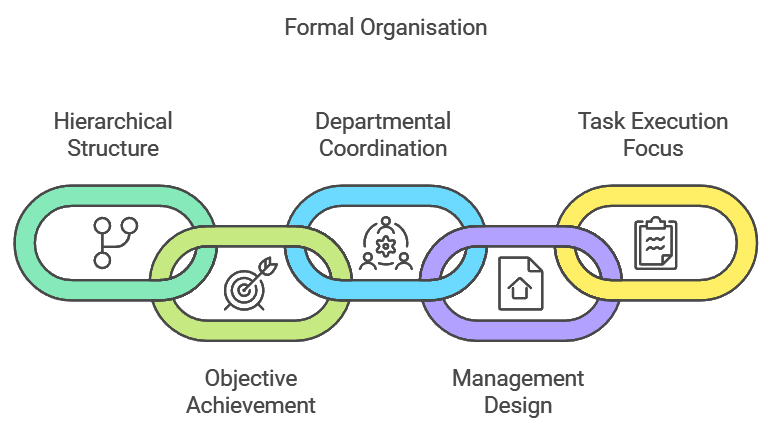 Formal Organisation
Formal Organisation
Advantages
- Clear Definition of Responsibility: Responsibility is easily ascertainable as mutual relationships are precisely outlined.
- Absence of Work Overlap: Work proceeds according to a well-defined plan, minimising the occurrence of overlapping tasks.
- Unity of Command: A clearly established chain of command ensures unity of command.
- Facilitates Objective Achievement: Coordination and optimal utilisation of human and material resources make it easier to achieve objectives.
- Organisational Stability: Predictable employee behaviour is fostered by specific rules, contributing to organisational stability.
Disadvantages
- Rule-Based Work Leading to Delays: The reliance on rules can result in unnecessary delays in the workflow.
- Lack of Initiative: Employees are constrained to follow instructions without the opportunity for independent thinking or initiative.
- Limited in Scope: Emphasis on structure and tasks makes it challenging to comprehend all human relationships within an enterprise.
2. Informal Organisation
Features
- An informal organisation stems from a formal one due to personal interactions among employees.
- The behaviour standards evolve from group norms instead of official rules and regulations.
- Group members develop independent channels of communication without a specified direction of information flow.
- The informal organisation emerges spontaneously, not deliberately created by the management.
- The informal organisation has no definite structure as it is a complex network of social relationships among members.
Advantages
- Speed: Information spreads rapidly as it does not follow prescribed lines of communication.
- Social Needs Fulfilment: Enhances job satisfaction, fostering a sense of belongingness in the organisation.
- Prompt Problem Resolution: Subordinates can openly discuss issues with officers, facilitating quick problem resolution.
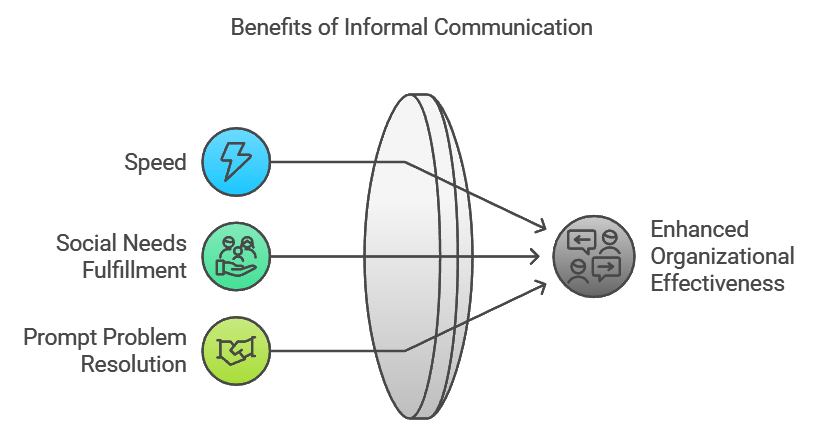
Disadvantages
- Rumour Creation: Informal discussions may lead to the spread of careless or incorrect information.
- Resistance to Change: Tends to resist change and emphasises adherence to traditional techniques.
- Priority to Group Interests: Encourages conformity to group expectations, potentially limiting individual perspectives.
Difference between Formal and Informal Organisation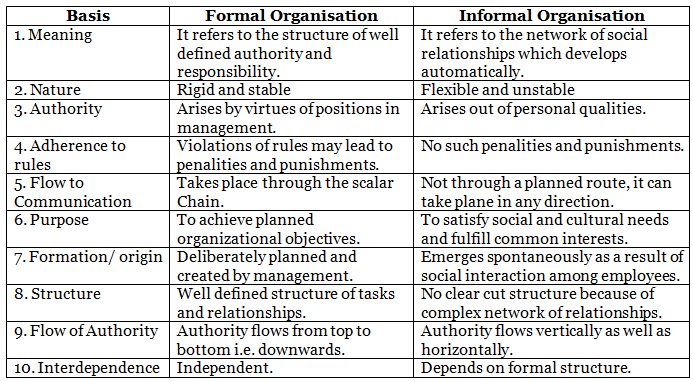
Delegation
- A manager, no matter how skilled, cannot do everything on his own. The amount of work is just too much for one person to handle. So, if a manager wants to achieve the goals of the organisation and make sure all the work gets done, he needs to delegate authority.
- Delegation means giving some of the manager’s authority to a junior or subordinate. This is important for the smooth running of the organisation. It allows the manager to focus on the most important tasks while also giving team members a chance to grow and take initiative.
- Delegation helps the manager get more work done through others. Without it, the manager would be limited to doing only what he can handle.
- But delegation doesn't mean the manager gives up responsibility. Even after passing on the authority, the manager is still accountable for the results. He can also take back the authority from a subordinate and give it to someone else if needed.
- In short, no matter how much authority is delegated, the manager remains responsible for making sure the work is done properly.
Elements of Delegation
According to Louis Allen, delegation means giving someone the responsibility and authority to do a task, and then holding them accountable for the results.
Let’s break down the three main elements of delegation:
(i) Authority
- Authority means the power to give orders and make decisions. A manager has the authority to tell their team what to do and expects them to follow. This authority comes from the official structure of the organisation.
- In any formal organisation, authority flows from the top to the bottom—the boss has more authority than their juniors. The higher the position, the greater the authority. This chain helps maintain order and allows managers to guide their teams.
- However, authority has limits. It must follow the laws and rules of the organisation. As you go higher in the organisation, the range of decisions a person can make also increases.
(ii) Responsibility
- Responsibility is the duty of a subordinate to complete the task assigned by their superior. It flows upwards, which means the subordinate is responsible to the person above them.
- When someone is given a task, they should also be given enough authority to complete it. For example, if you're asked to do a job, you need the tools and permissions to do it well.
- If you have more authority than responsibility, you may misuse power. But if you have more responsibility than authority, you may feel helpless and not perform well.
(iii) Accountability
- Accountability means being answerable for the results of your actions. Even after delegation, the manager is still accountable for the final outcome. Accountability cannot be passed on—it always flows upwards.
- This means the subordinate must report back to their superior and explain what was done and why. Regular feedback and check-ins are used to make sure everything is on track.
Difference between Authority, Responsibility and Accountability

Importance of Delegation
Delegation allows managers to hand over tasks to subordinates, which reduces the manager’s workload and gives them more time to focus on important issues. When done properly, delegation offers many benefits:
(i) Effective Management
When managers delegate routine tasks, they get more time to focus on key matters. This improves their efficiency and gives them the chance to work on new ideas and areas for growth.
(ii) Employee Development
Delegation gives employees a chance to show and improve their skills. They get to handle more challenging tasks, which helps them grow and prepare for higher roles in the future. It helps turn employees into better leaders and decision-makers.
(iii) Motivation of Employees
Delegation boosts employee confidence. When a manager trusts an employee with a task, it builds the employee’s self-esteem and makes them feel valued. This trust encourages them to perform better and take more responsibility.
(iv) Facilitation of Growth
As the organisation grows, it needs more skilled leaders. Delegation helps create a trained workforce that can take on key roles in new branches or projects. Experienced employees can carry forward the work culture and values to new ventures.
(v) Basis of Management Hierarchy
Delegation sets up a clear chain of command. It defines who reports to whom and how much authority each position holds. This forms the basic structure of management within the organisation.
(vi) Better Coordination
Delegation clearly defines authority, responsibility, and accountability. This helps avoid confusion, overlapping tasks, and wasted effort. Everyone knows their role, which improves coordination between departments and levels of management.

Decentralisation
- Decentralisation is the practice of giving authority to lower levels of an organisation, except for what must be decided at the central level.
- Complete centralisation would mean all decision-making is done at the top of the management hierarchy, eliminating the need for a management structure.
- Anything that enhances a subordinate's role is considered decentralisation, while anything that diminishes it is centralisation.
- An organisation is seen as highly decentralised when many important decisions are made at lower levels.
- As noted by Allen, “Decentralisation” involves a systematic effort to delegate authority to the lowest levels.
- In simpler terms, decision-making power is transferred down the chain of command.
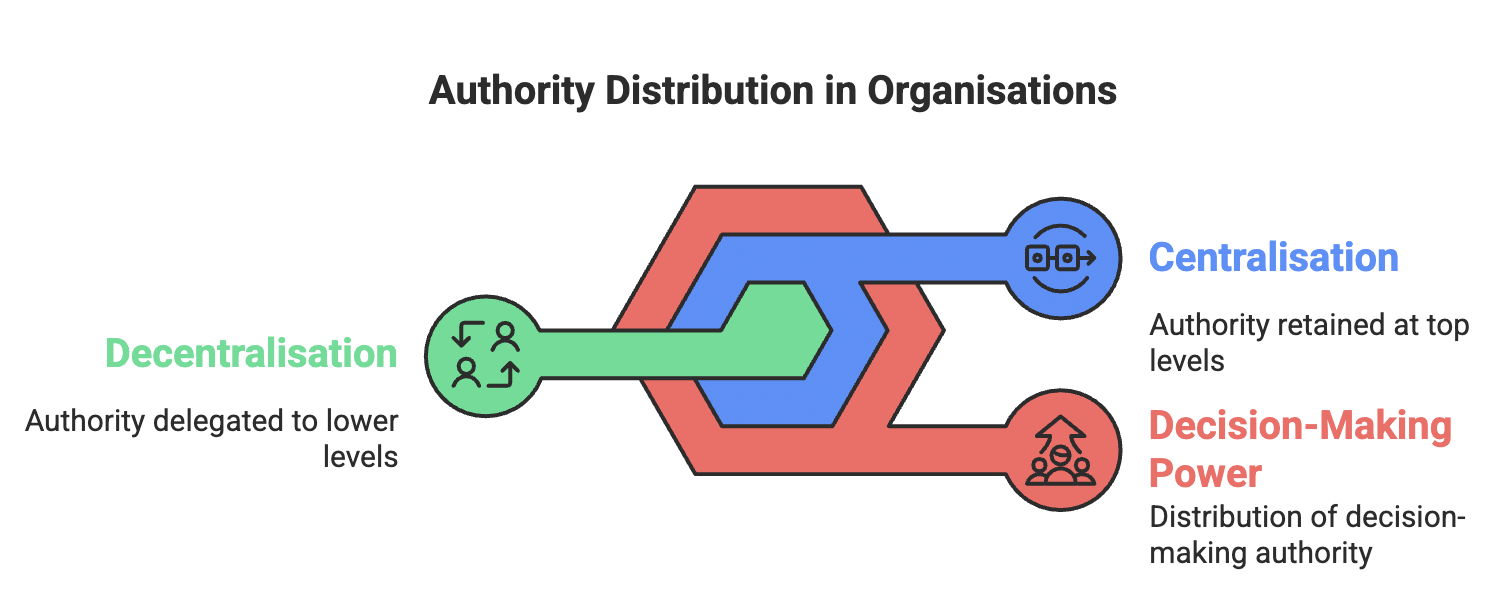
Centralisation
Centralisation implies the concentration of authority at the top level, while decentralisation involves the systematic delegation of authority at all levels and in all departments of a firm. A balanced approach between the two is essential for effective organisational functioning.
In a decentralised firm, the top level retains authority for:
- Formulating policies and making decisions concerning the entire firm.
- Exercising overall control and coordination.
Meanwhile, the middle and lower levels are granted the authority to make decisions related to the tasks assigned to them.
Centralisation and Decentralisation
Centralisation and Decentralisation refer to the distribution of authority among managers at various levels. Centralisation involves consolidating decision-making power in a select few, limiting the delegation of authority to managers at middle and lower levels. Complete centralisation or decentralisation is impractical; instead, a balance between the two is necessary. As an organisation expands, there is an inclination toward decentralisation. Consequently, every organisation exhibits elements of both centralisation and decentralisation.
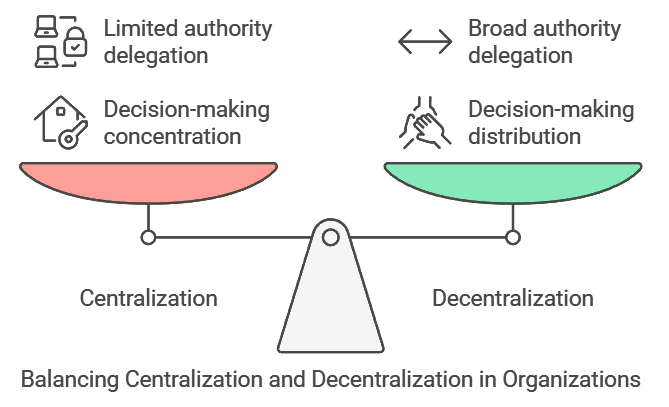
Importance of Decentralisation
- Encourages initiative among subordinates: Decentralisation promotes self-reliance and confidence in subordinates. When lower management is allowed to make their own decisions, they learn to trust their judgment. This also keeps them challenged, requiring them to find solutions to the problems they face.
- Faster decision-making: Management can be seen as a communication chain. In a centralised organisation, decisions made by top management slow down information flow since it must go through many levels. This delay hinders quick responses and makes it hard for a company to adapt to changes. In contrast, a decentralised organisation allows decisions to be made closer to the action, speeding up the process.
- Reduces excessive workload for top executives: By delegating daily management tasks to subordinates, top executives can focus more on developing new strategies. Direct supervision is often replaced by other methods of control, such as return on investment.
- Builds future managerial talent: While formal training equips subordinates with the necessary skills for advancement, gaining experience from independent assignments is equally important. Decentralisation gives them opportunities to showcase their capabilities, creating a pool of qualified individuals for higher positions through promotions.
- Supports growth: Decentralisation grants more autonomy to lower management and departmental heads. This allows them to operate in ways that best suit their departments and encourages competition among them. As a result, each department strives to excel, leading to increased productivity and higher returns for expansion.
- Improves control: Decentralisation allows for assessing the authority of each job position within the organisation. It facilitates performance evaluations at every level, leading to better oversight of all activities.
Difference between Delegation and Decentralisation
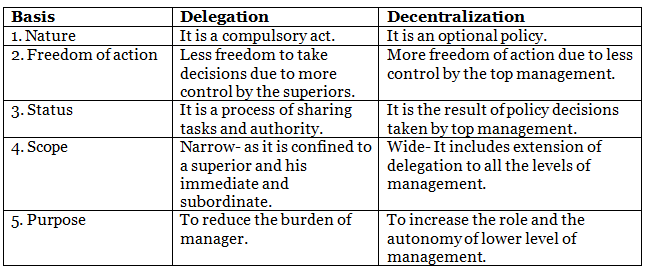
|
51 videos|230 docs|49 tests
|
FAQs on Organising Chapter Notes - Business Studies (BST) Class 12 - Commerce
| 1. What is the meaning of organizing in management? |  |
| 2. What are the main steps involved in the process of organizing? |  |
| 3. Why is organizing important for an organization? |  |
| 4. What are the different types of organizational structures? |  |
| 5. What is the difference between formal and informal organization? |  |

















